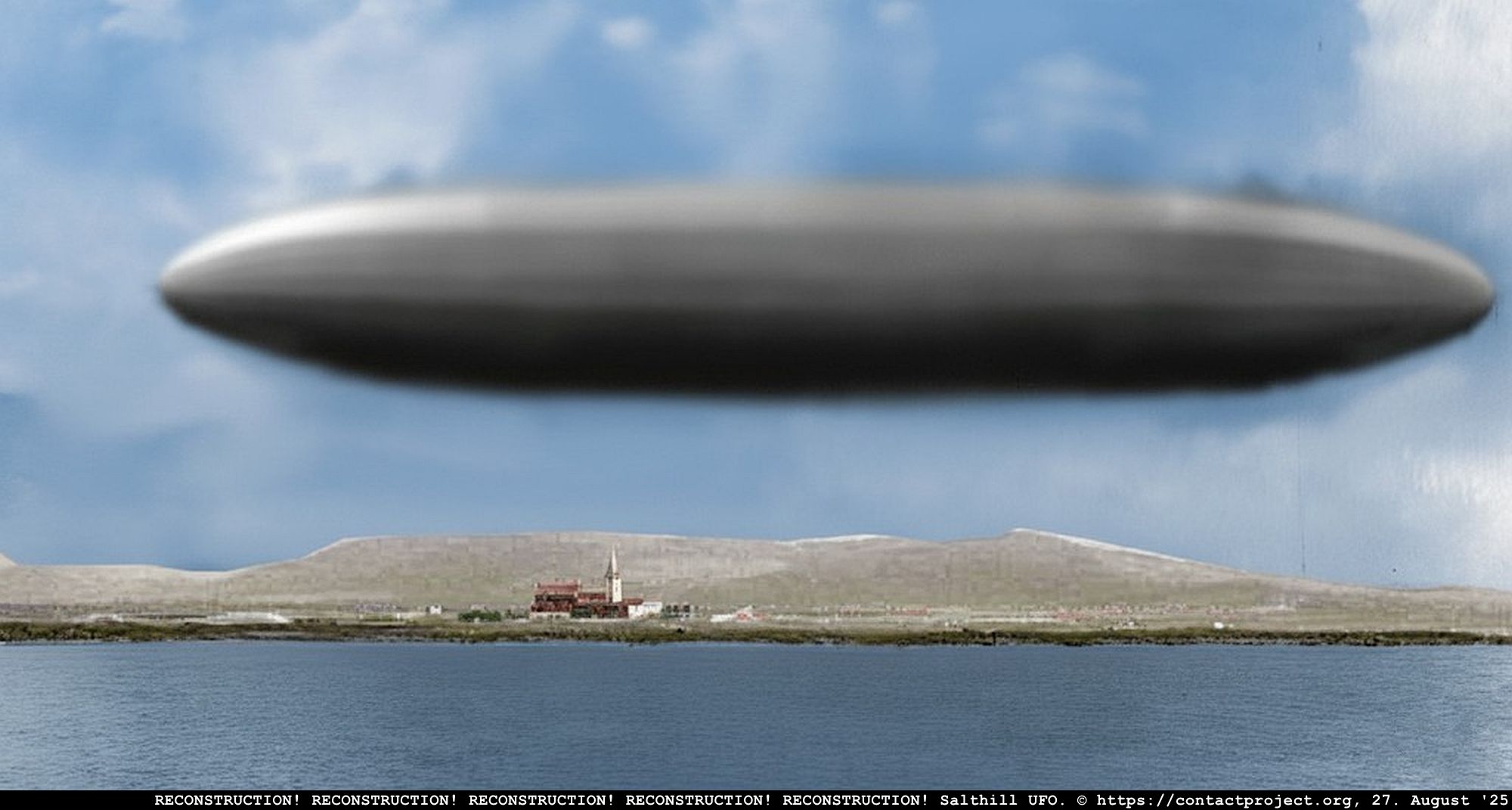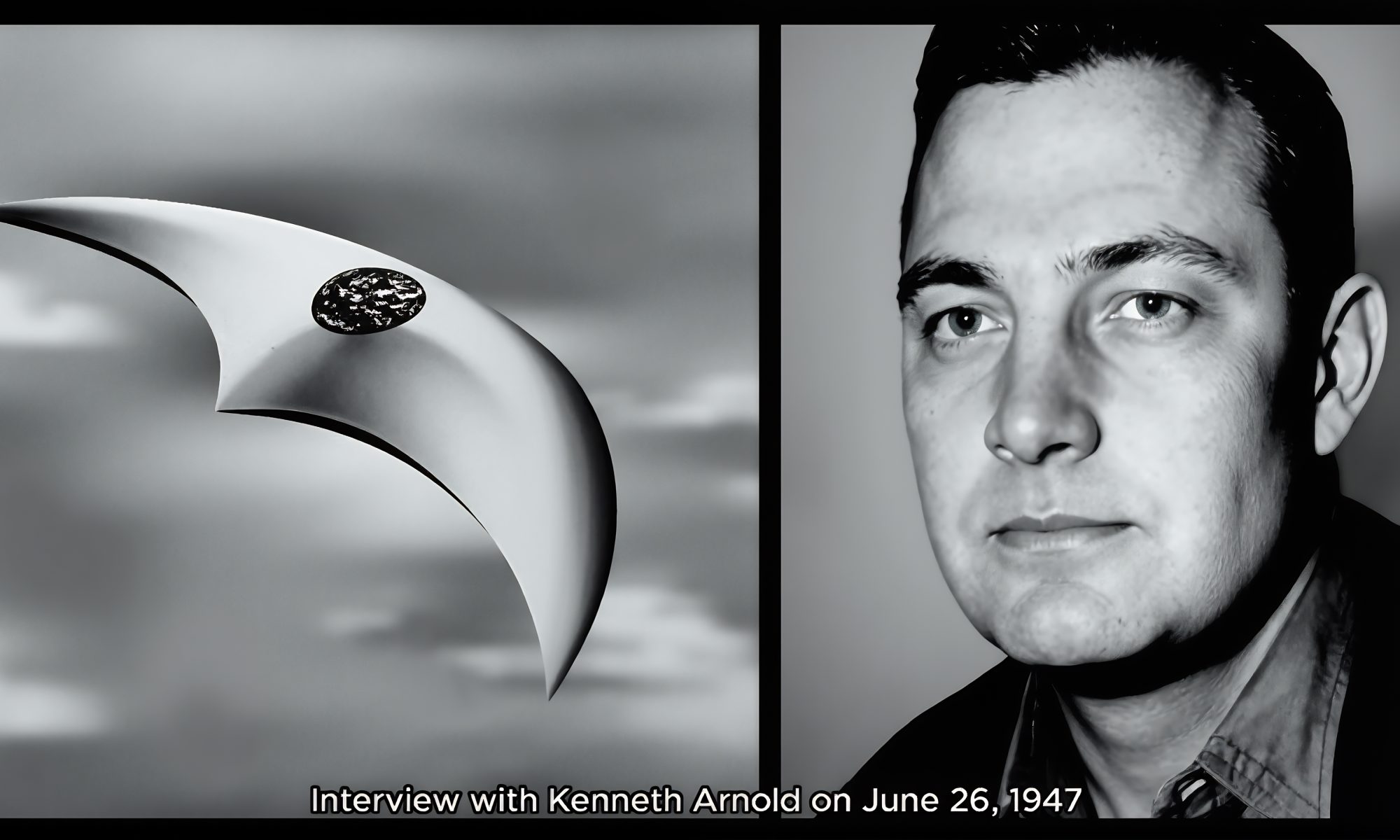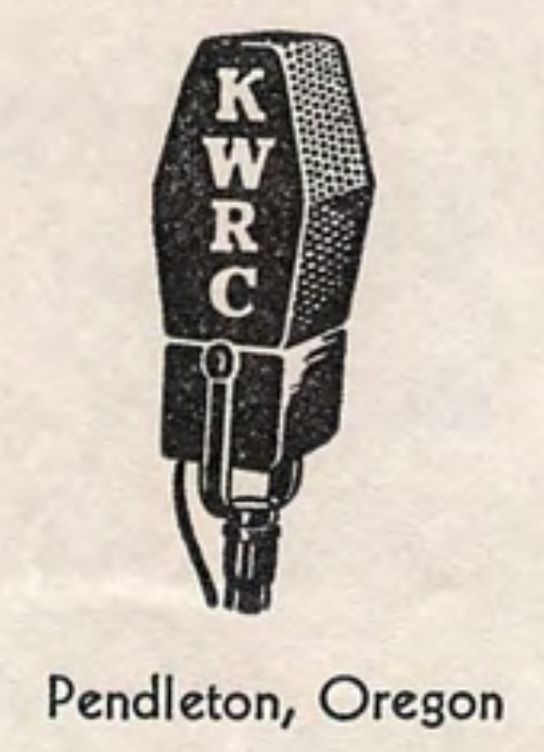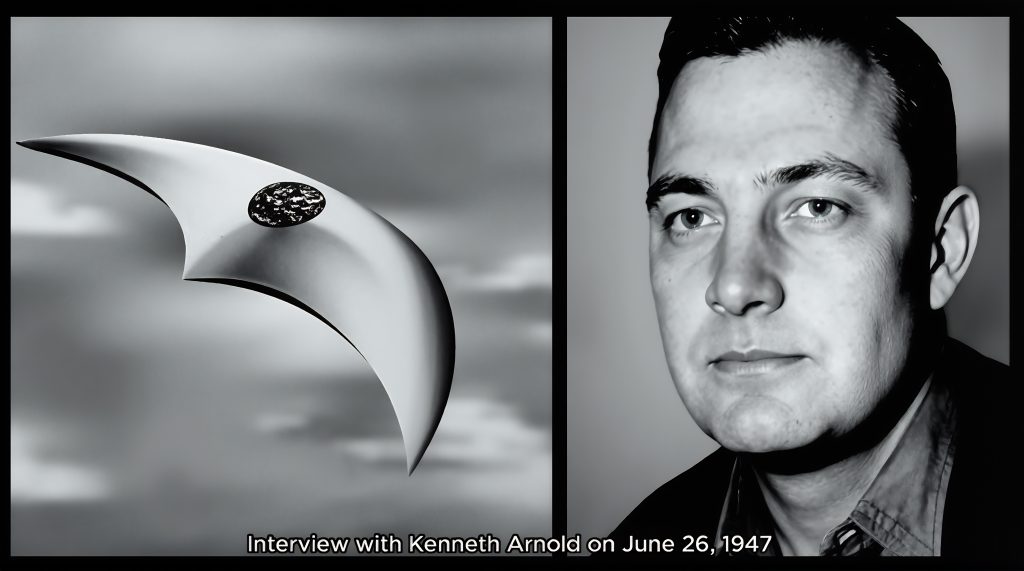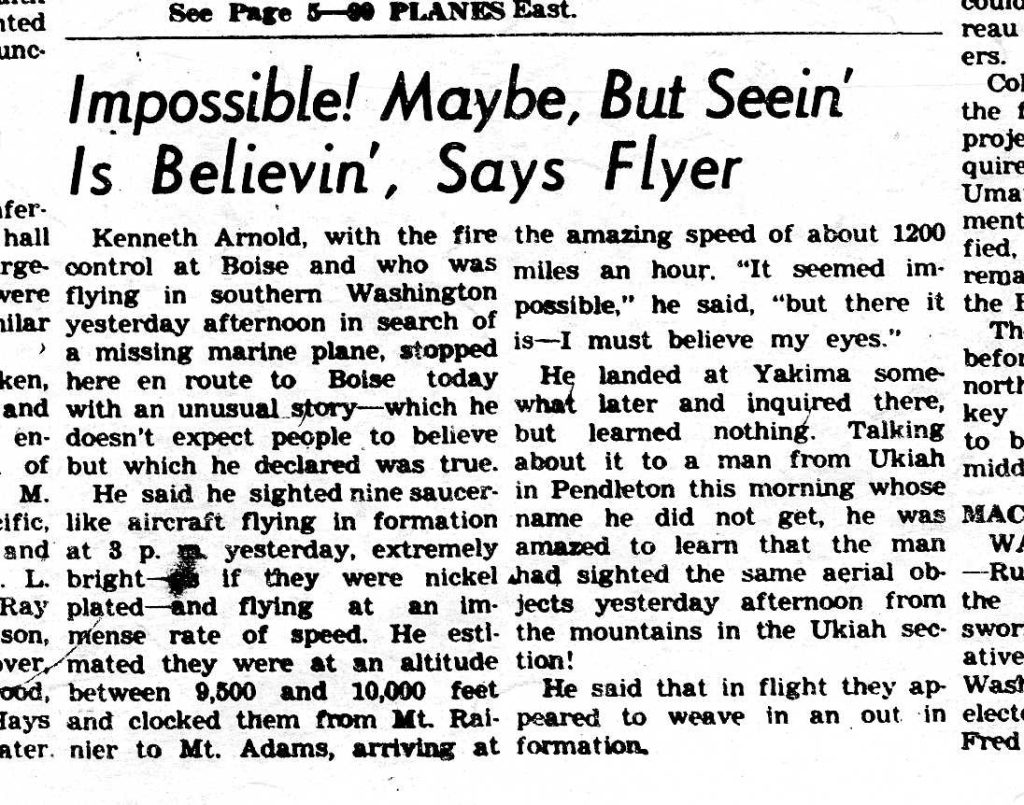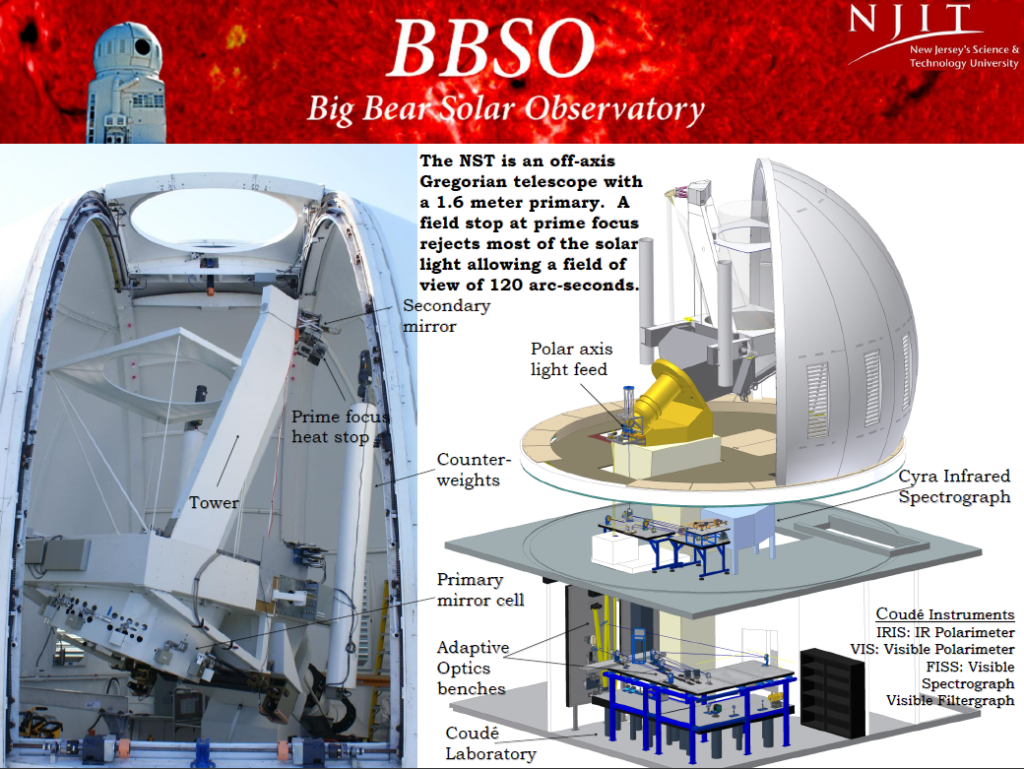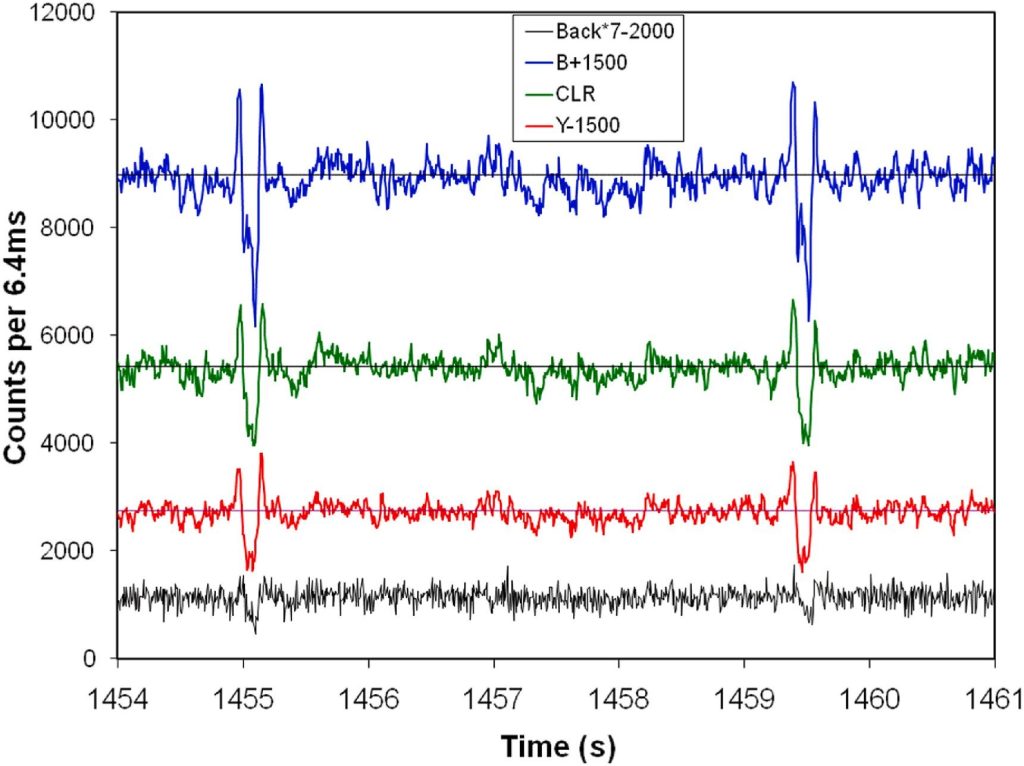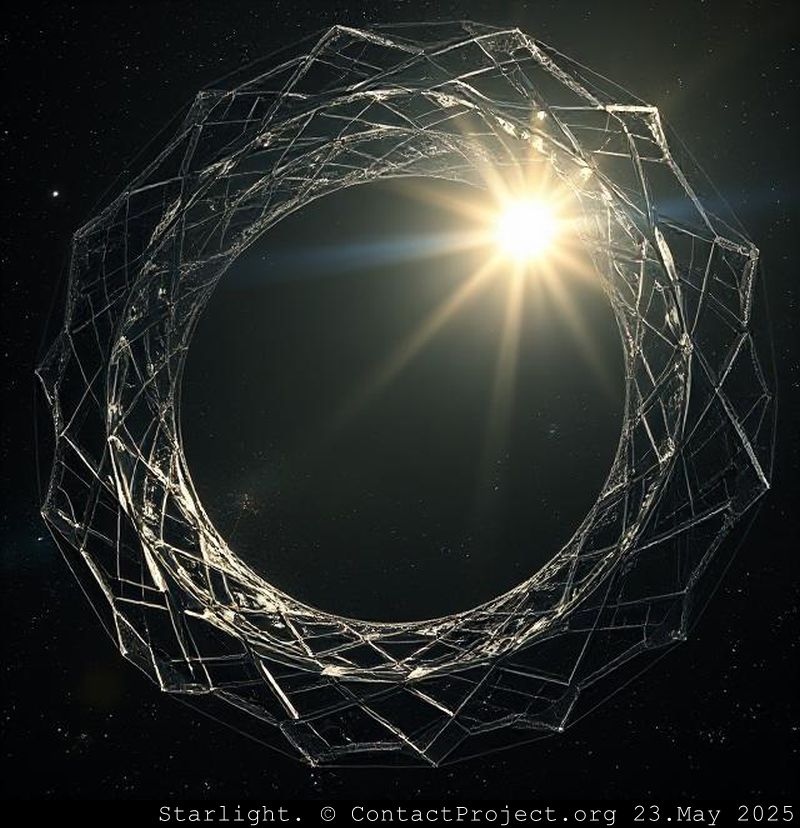🕔 Estimated reading time: 20 minutes
The true story of a man who went up a hill and came down a mountain.
The Salthill UFO encounter occurred on a cold Sunday morning in Galway, 23 February 1986. When I first recorded the event in 2016, I believed it was the only time I had witnessed something that did not belong in our skies. Later, however, I realized that was not the case. The sighting unfolded in Salthill, but the object itself hovered out over the Claddagh.
Table of contents
- An Unexpected Adventure
- The Cigar-Shaped Object
- Searching for Answers
- Seeking Witnesses
- Headlines
- “UFO flap reported over Irish Sea”
- Parallel Sightings at about the same time
- Different phenomena
- Thirty Years Later
- Discovery of the Claddagh Circles
- A Possible Archaeological Connection
- The Artist Responded
- Connecting Art and Myth
- The Legend of the Tuatha Dé Danann
- Present Day: A Mythic Landing Site
- Gods from the Sky
- THE BLACK UFO REPORT UPDATE – 1 Oct 2025
- The Black UFO report
- Report Summary – 23 February 1986 UFO Events
- Epilogue & Conclusion
An Unexpected Adventure
The 1986 experience kicked off an unexpected adventure, one that took me from the hills of Salthill to the icy shores of Greenland.
Life in Galway was simple. For me, one of the greatest pleasures was walking along the coastal promenade, “the prom,” as everyone called it. My neighbours in Fairlands Park had a boisterous ten-month-old puppy named Rocky, and I often took him out to burn off some of that boundless energy.
That morning was a fine one. Although a cold spell persisted, the sky was a wide blue expanse, bright with sun and dotted with a few clouds. The grass in the field was still covered in a crisp layer of frost. The air was invigorating and fresh.
“Come on, Rocky,” I said, tugging at his leash. “Let’s get a move on before the weather changes its mind.”
It was about eleven o’clock when we began making our way up the hill on Dalysfort Road toward Salthill Beach.
The sky and the weather in Ireland are notoriously changeable, so I examined the sky to check for any signs of rain. As I tilted my head back, scanning the clouds, something caught my eye.
The Cigar-Shaped Object
Framed perfectly between the rooftops of a row of houses a solid, grey, cigar-shaped object hung silently in the air. It was utterly still. Rocky, meanwhile, was far more interested in a promising-looking patch of grass.
I didn’t have my 35mm camera with me, a fact I regretted for years.
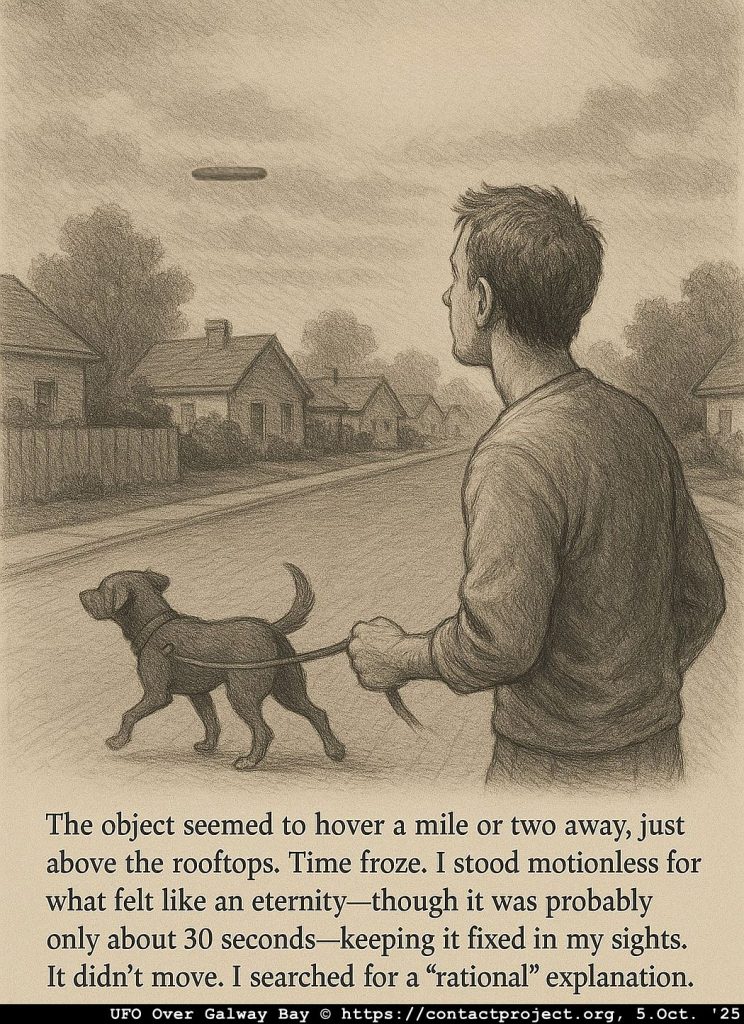
The object seemed to hover a mile or two away, just above the rooftops. Time seemed to freeze. I stood motionless for what felt like an eternity – though it was probably only about 30 seconds – fixing it in my sights. It didn’t move. I contemplated it, searching for a “rational” explanation.
I thought to myself that, had I not been walking with Rocky, it might have looked strange to any onlookers: a man suddenly stopping dead in the middle of the road to stare at the sky. But with a dog, that was normal. Dogwalkers stopped in their tracks all the time. Rocky, meanwhile, kept tugging at his leash.
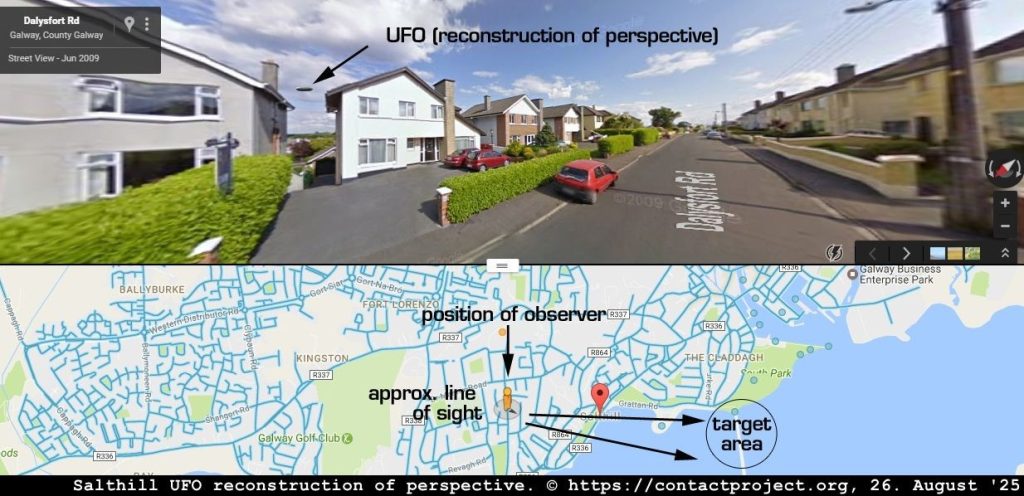
“It looks like a Zeppelin,” I finally murmured to myself, dismissing the idea that I was seeing a UFO.
I continued walking, keeping the object in sight. But due to the change in perspective, a house and some trees slid in front of it, temporarily, for few seconds, blocking my view.
Naturally, I expected the object to reappear on the other side as we cleared the obstruction.
But it didn’t. The patch of sky where it should have been was empty. The object was gone.
Searching for Answers
“Hold on a minute,” I said, turning around. Rocky looked up at me, confused. I walked back to the exact spot where I’d first seen it. Nothing. The sky was just sky. A slow-moving blimp would still be there, or at least nearby. This was just… gone.
It had vanished in a matter of seconds. I paced back and forth in disbelief, willing it to reappear where it was before. But no cigar. Rocky whimpered impatiently. Finally, we carried on.

Down at the Salthill promenade, we turned left at the Western House corner store. The green across the road buzzed with activity. In spring 2016 a full-blown festival was underway. At the seafront, I scanned the wide-open sky one more time. Clear.
Seeking Witnesses
A question crossed my mind: could others have seen the same object as me? I overcame my naturally shy nature to quiz a few people milling about:
“Have you just seen a blimp or any balloons in the sky here?” It felt like being a market researcher. I just got shrugs and headshakes in response
Then I spotted my friend, Jim, who owned the local amusement arcade. “Jim, good to see you!” I shouted over the noise of a live band. “What’s all this then?”
“College Week, Eric!” he grinned. “Or Rag Week, depending on how much of a mess they make. You look like you’ve seen a ghost.”
“Not a ghost,” I said, lowering my voice. “More like… a blimp? Did you see anything up there in the sky? Big, grey, cigar-shaped?”
Jim laughed. “The only thing I’ve seen in the sky is my profits from the slot machines. You’ve been working too hard, mate.” He gave me a funny look, and we left it at that. College week carried on and came to a close on the 1st of March.

Galway Advertiser archive, 27th February, 1986 pg. 21:
“COLLEGE Week is in full swing at the moment. Tonight is a fancy dress Rock ‘n Roll night at Leisureland with John Keogh and Full Circle.“
From this, we know College week 1986 ran from Sunday, February 23, to Saturday, March 1, 1986. There are no other records for the timing of College Week in 1986.
Thanks go to the archivist of the Galway Advertiser.
Headlines
About two weeks later, I went on another walk to Salthill promenade. I went inside Western House corner store to buy cigarettes. Scanning the magazine rack, a headline jumped out:
“UFO flap reported over Irish Sea”
My heart pounded. I grabbed the magazine and read the article on the spot. It turned out I wasn’t the only one who had seen something strange that week. (If anyone knows what magazine this may have been, please let me know.)
It was a small piece of a much larger puzzle.
Parallel Sightings at about the same time
Thirty years later I began writing about this encounter. I searched online for any verification that I hadn’t dreamed the whole episode. So, in 2016 I found these pieces of information:

“Charles in UFO Riddle”
On 23rd February 1986, according to the Sunday Mirror, Prince Charles was flying over the Irish Sea in a RAF VC-10, returning from the USA. The pilot reported a glowing red object to Shannon air traffic control that had lit up the cockpit. The Ministry of Defence confirmed there was no danger. Other aircraft in the area reported the same object.
Miles Johnston, an investigator in Belfast, allegedly saw a red fireball with a tail over the Irish Sea on 23rd February and reported it to Armagh Observatory. This account appears in “Northern UFO News, number 118” from 1986. In this publication the editor Jenny Randles expresses doubt at the Sunday Mirror reporters.
I have not found any record of Miles Johnstons report to Armagh Observatory (yet).
In his book “Extra-Terrestrials Among Us,” George Clinton Andrews recounts the Prince Charles incident. Prince Charles is quoted as saying, “I felt I was in the presence of something outside our knowledge or control.” The book cites the Sunday Mirror article as a source.
For a full update on sightings on the 23. Feb 1986 in Ireland and England jump to the BLACK UFO REPORT! There are 6-7 officialy documented sightings from the MOD UFO desk on that night!
Different phenomena
My own sighting from 11:00 in Galway, Eire is not the same phenomenon reported later that night. They are separate events, occurring on the same date – 23 February 1986. What the Ministry of Defence UFO files (DEFE 31/174/1 & DEFE24/1924/1) do confirm is that other sightings were indeed logged that day, reported by airline crews, motorists, and air traffic controllers across the UK and Ireland. Actually, there were over 8 independent reports.
Thirty Years Later
I had banished this memory for nearly 30 years. In 2016 I reengaged and reconstructed what I had seen that day in 1986, close to Mutton Island in Galway.
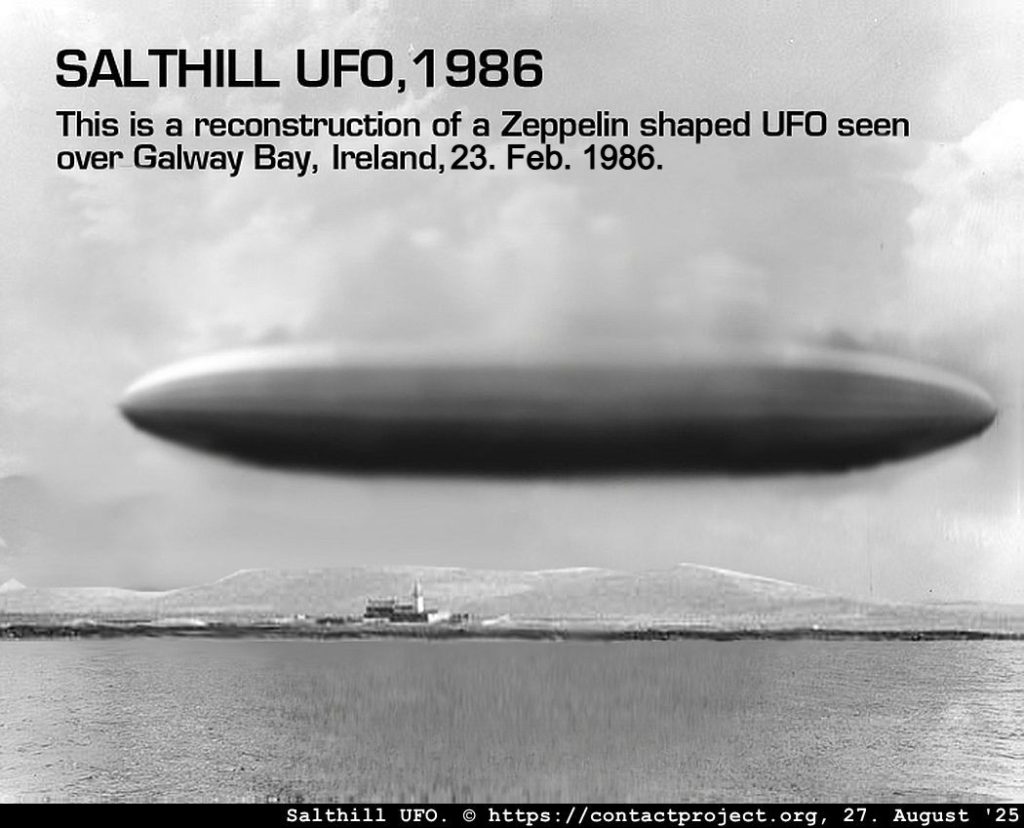
I reported the UFO to MUFON (Case #82139) and tried to recall every detail. Studying Google Maps, I noticed odd circles on Claddagh Beach. They reminded me of the X‑Files episode “Biogenesis.” Wait, hadn’t I seen these before, in 1999?
Discovery of the Claddagh Circles
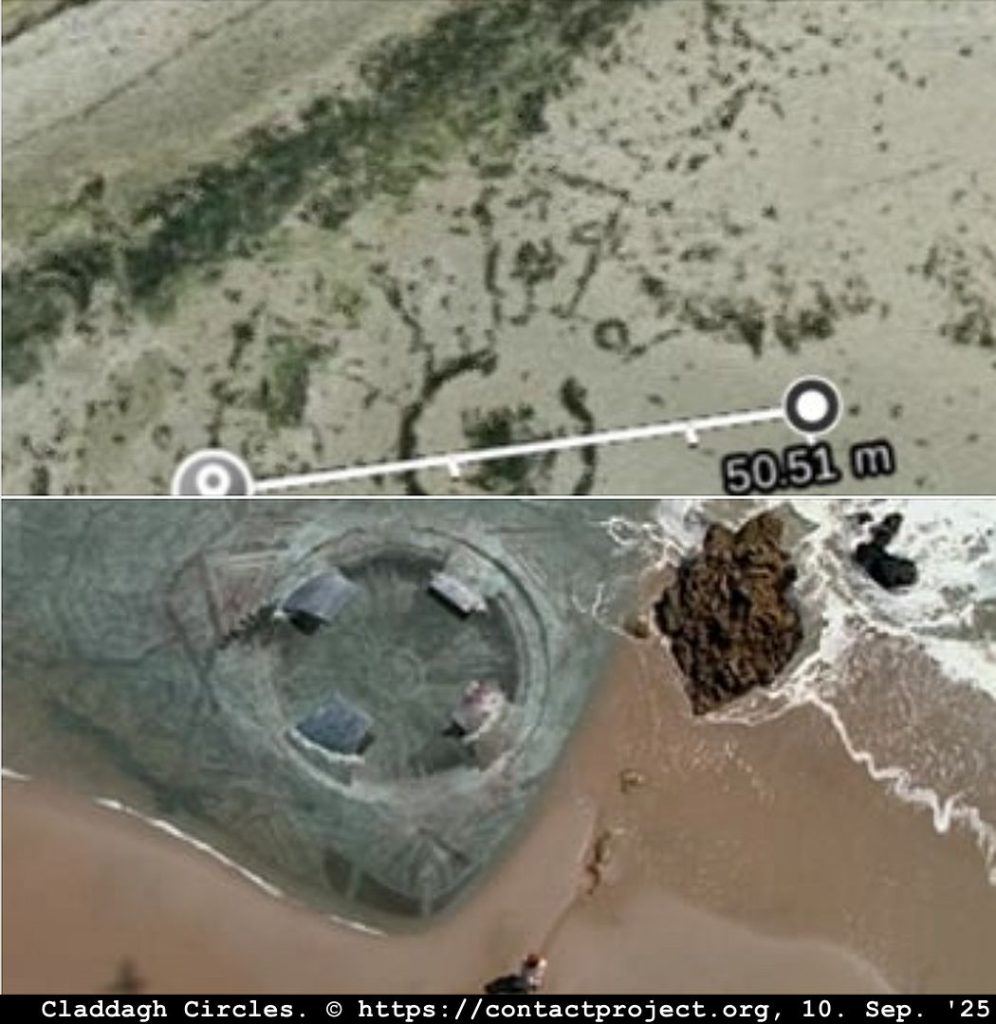
Indeed, I had photographed one for my website Virtual Galway and asked locals about them – no one knew.

How strange. Since no one knew what these were, I wondered if these circles were perhaps a new type of “permanent crop circle” – remnants of the 1986 sighting. I felt very hopeful. The mystery of these circles lingered in my mind. Their perfect geometry and unexplained origin seemed almost otherworldly, as if they were a message left behind.
A Possible Archaeological Connection
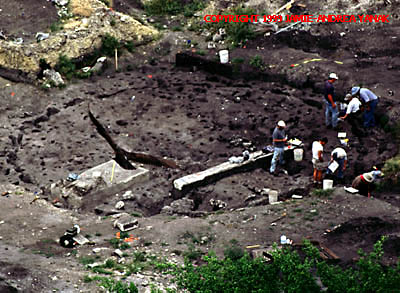
After some research they began to remind me of the Miami circles, remnants of prehistoric roundhouses discovered in Florida. Eager to get to the bottom of this, I contacted the archaeological department at the University of Galway. I wondered if perhaps there was some overlooked archaeological significance.
Within two hours Dr. Sherlock (that’s really his name), the Director of the Galway Archaeological Field School, responded: the circle structures were designed by Martin Byrne and Padraig Conway as part of the ‘Solas Atlantis Galway 1993’ art project. I thanked Dr. Sherlock and added that I had already contacted archaeologist Martin Byrne five days earlier. In my message, I even joked that Martin was probably laughing all the way to the pub, since I had linked the circles to a UFO sighting:
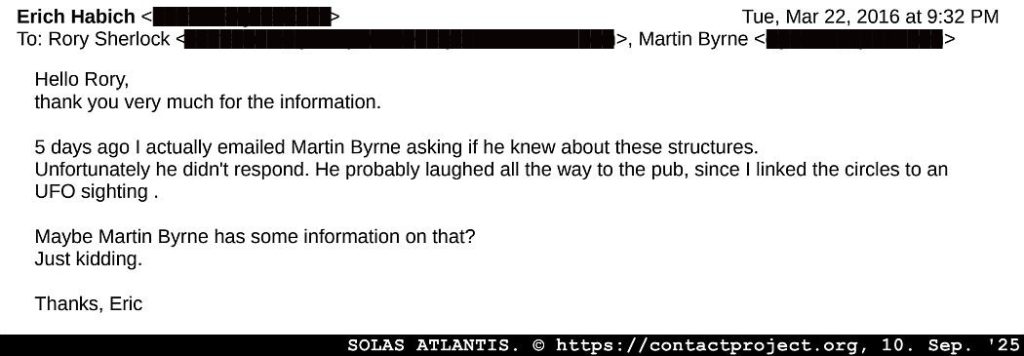
I wrote that email in jest. How could Martin have any information on unidentified flying objects, right? Surely, there was no connection between an art installation and any cosmic conundrum. But I would soon discover that this spot had a mythology of strange sightings. Curiosity turned into anticipation as I waited for Martin’s reply, wondering if there might still be a hidden story behind the art.
The Artist Responded
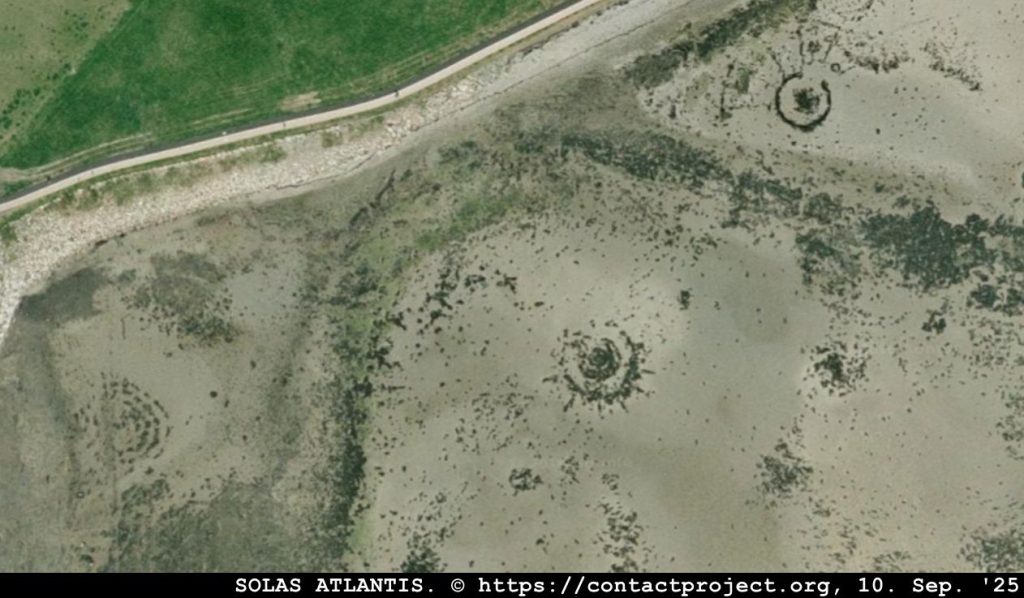
Then, the creator of the circles, Martin Byrne, got back to me. He had named the circles “Solas Atlantis,” apparently from Old Irish solas (“light, brightness”), related to solus (“light”) in Latin. The translation therefore is “Light from Atlantis”.
Martin said that this was an environmental art project, loosely inspired by Native American medicine wheels, Irish megalithic art, and the proposed sewage plant on Mutton Island. The artwork was a dialogue between the ancient and the modern, the natural and the constructed.
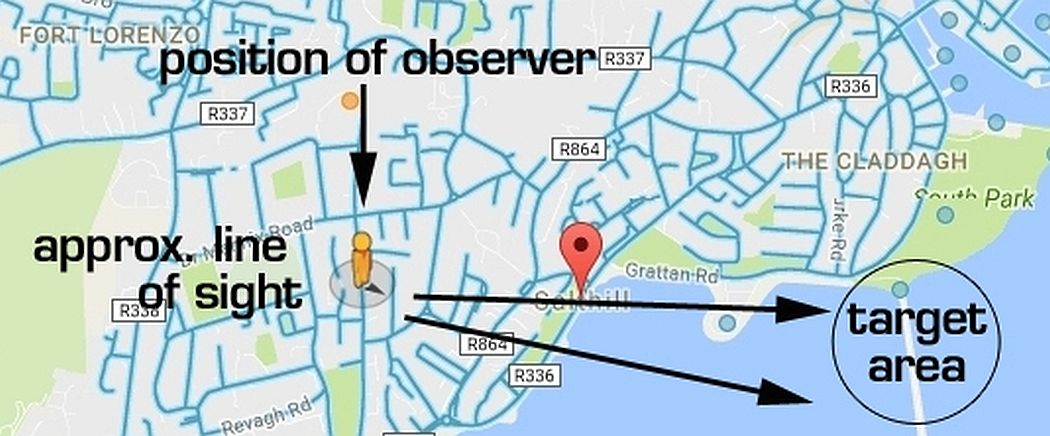
The intersection of art, and my own experience was becoming increasingly compelling, drawing me further into the web of Galway’s mysteries.
Connecting Art and Myth
What Martin Byrne didn’t mention explicitly was the connection of his art installation to the origin story of the Irish people: the legend of the Tuatha Dé Danann. These were not mere mortals but old pagan gods, recast as magical heroes by medieval monks in the Irish origin story, the Lebor Gabála Érenn (The Book of Invasions).
The Legend of the Tuatha Dé Danann

Two traditions describe their arrival: by the Northern or the Southern route. I focus on the Southern route, with the landing at Galway, as it aligns with my UFO sighting – unlikely as that may sound. The Southern version was especially popular in the 18th and 19th centuries, supported by antiquarians who recorded local folklore. Sir William Wilde, father of Oscar Wilde, described the Southern route extensively in his 1867 book Lough Corrib: Its Shores and Islands. The tales painted vivid pictures of ships emerging from the clouds, mysterious artifacts, and beings beyond comprehension.
Present Day: A Mythic Landing Site
As I explore these legends, I can’t help but draw parallels to what I had witnessed. The line between myth and memory feels thinner than ever.

Could it be that the legends preserve some distant truth? The convergence of my sighting, the site of the circles, and the mythic landing place seems almost too coincidental. I see the landscape itself as a tapestry, woven from stories, memories, and mysteries waiting to be uncovered.
Gods from the Sky
The Tuatha Dé Danann came in great ships like clouds, that flew through the air, bringing magical treasures: a sword of light, a healing stone, and more. They were God-like beings, “the shining ones”, immune to ageing and sickness, with the abilities of healing and shape-shifting. They brought civilization, arts and advanced skills to Ireland.
Was it over Galway Bay, that the mythological Tuatha Dé Danann arrived in dark cloud ships, (maybe burned some of them), and then landed on a mountain further inland?
The position of my 1986 sighting – over the Claddagh, near Byrne’s Solas Atlantis – makes me wonder. The border between what I have seen and what the legends describe feels blurred, as if the past and present were in quiet conversation across Galway Bay.
To follow the trail of the Shining Ones, we must turn from Salthill’s vanished sky-ship to the Southern route of legend – Galway Bay to Cong, where myth and mystery converge.
If you prefer, you can skip ahead to Chapter 3:
- UFO Over Galway Bay Chapter 1: The 1986 Salthill Encounter
- The Black UFO Report: Prince Charles, a Jumbo Jet, and a Night of Aerial Mysteries
- UFO over Galway Bay Chapter 2: Psychic Mayday from a crashed UFO
- UFO over Galway Bay Chapter 3: The Irish Tuatha Dé Danann as Cosmic Visitors
- UFO Over Galway Bay Chapter 4: Reverse Engineering The Quantum Coupled Transistor
- The Quantum-Coupled Transistor (QCT): Amplifying the Void
- Can Information Travel Faster Than Light – Without Breaking Physics?
THE BLACK UFO REPORT
UPDATE – 1 Oct 2025

The title “Black UFO Report” is derived from the color of the MOD file addressing the Prince Charles sighting, partially redacted and sealed until 2071. ⤓ Download the full report here as PDF⤓ (click).
Evidence Collection
In searching for evidence – beyond the Sunday Mirror tabloid story – that my own UFO sighting on 23 February 1986 was part of a UFO flap (as I recalled from a magazine headline), I submitted several FOI requests regarding Irish and British UFO reports from that day. And, to my surprise, I got lucky! (Link to interactive map of all the sightings.)
The British National Archives responded with the Ministry of Defense UFO files DEFE/24/1924/1 and DEFE/31/174/1. Based on their response and other archival findings, I was able to reconstruct the entire day, including the notable Prince Charles flight. And I found an additional 7 sightings listed in the MOD UFO files! (A full listing with references is given towards the end of this report.)
✈️ Prince Charles’s Flight reconstruction per United Press International archive
Aircraft: RAF Vickers VC10 “Queen of the Skies”
Date: Sunday, 23 February 1986
Approx. Departure in California: 01:30 PST
Flight time: ~10:30h
Sunset in Ireland: about 18:02 GMT
Over the Irish Sea: ~19:37 GMT (UAP illuminates cockpit)
Arrival in UK: ~20:00 GMT (per UPI report)
Document Analysis
HOWEVER, the information released via the Freedom of Information request in the MOD documents is incomplete because:
“…the document contains the names and addresses of members of the public … Release could lead to press intrusion into their lives. This exemption will remain in place for 84 years (until) …2071.”
The following table compares what’s known from the Sunday Mirror article (via a press leak) vs. the official MOD documentation:
| Source | What is Reported | What is Missing / Withheld |
|---|---|---|
| Sunday Mirror (2 Mar 1986) | • Prince Charles’s RAF VC-10 crew saw a red glowing object light up the cockpit.• Four other aircraft also reported the same UFO over the Irish Sea.• MOD launched immediate investigation; no missing aircraft found.• Experts ruled out meteors or space debris.• Official quote: “It’s a complete mystery.” | • No names of pilots/airlines.• No times or positions of the other four aircraft.• No ATC transcripts or technical details. |
| MOD File (DEFE 31/174/1 extract) | • A Lyneham Ops sighting report filed.• Remarks: “An American 747 captain reported similar sighting near Shannon, Ireland. Object/apparition lit up his flight deck. LATCC have knowledge of this particular incident.” | • The 747’s original report (captain’s statement, ATC log) is not included.• No flight number, crew names, or airline identified.• Likely withheld under FOI Section 40(2) (personal data exemption). |
| MOD FOI Response | • Confirms DEFE 31/174 is partly closed until 2071.• Cited Section 40(2) FOI exemption (Data Protection Act).• Withheld data includes names/addresses of witnesses (both public and MOD staff). | • Any documents containing personal identifiers (pilots, airlines, MOD staff) remain unreleased.• This almost certainly includes the Shannon 747 report and possibly additional aircraft reports (VC10). |
It appears the press had the full narrative.
The Black UFO report
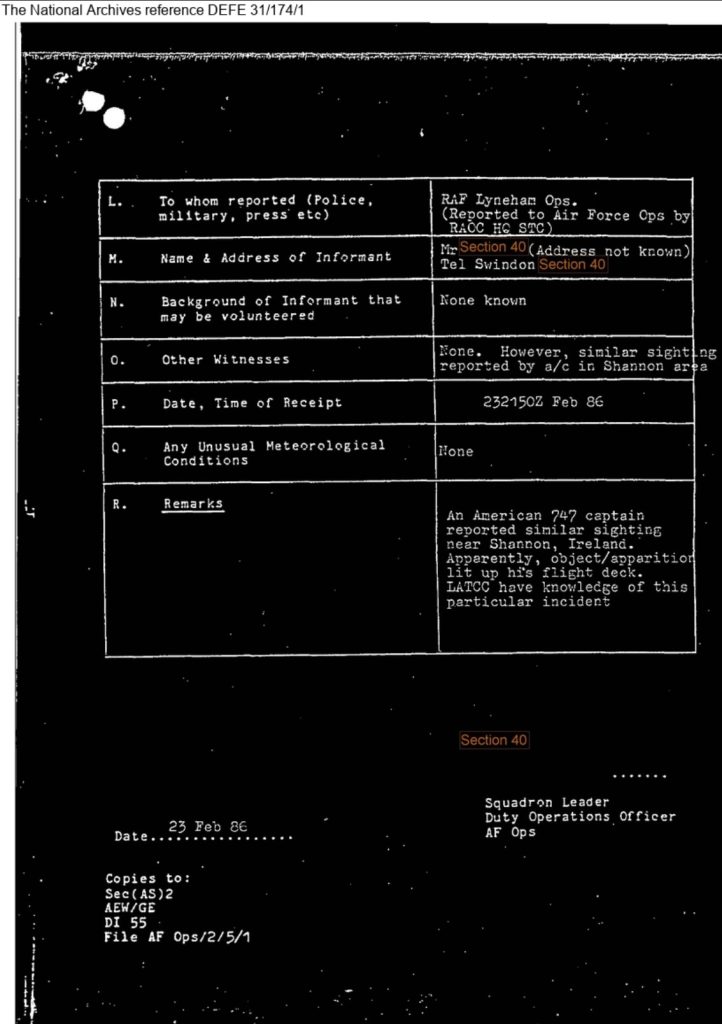
In the released MOD papers one document sticks out, because it’s a negative print, indicating that it had been microfilmed. I believe this document is linked to the Prince Charles VC10 encounter, as it references an airline pilot at Shannon who had a similar experience to the VC10 pilot, according to the Sunday Mirror.
The only weird thing is, in the report the sections A to K are missing. And how does this relate to the MOD file which includes the Sunday Mirror article?
The UFO reporting chain (according to Manual of Air Traffic Services MATS Part 1):

The reporting chain graphic explains the black UFO report. The 747 Crew sighting is included via LATCC. But the VC10 crew report is redacted until 2071, presumably because one Very Important Passenger could be identified on that flight. That’s why only sections L-R are visible; A-K, which would have included the place of observation and the description, are missing.
Event Summary – 23 February 1986 UFO Events
So, here’s an interactive map of 23 February 1986, showing the total series of 9 unusual reports sweeping across Britain and Ireland – amounting to a previously unreported full UFO flap.
Interactive map: https://contactproject.org/wp-content/uploads/2025/10/1986_UFO_sightings_interactive_cluster_purple.html
Report Summary – 23 February 1986 UFO Events
1. Galway, Ireland (11:00) screenshot of MUFON #82139 database
Large structured UFO hovered silently over Galway Bay in daylight before vanishing. Only clear daytime structured craft sighting of the day.
2. VIP Flight, RAF VC-10 (19:37, Irish Sea) from MOD file DEFE24/1924/1 Sunday Mirror & MOD file DEFE31/174/1 (missing sections A-K)
Prince Charles’s crew saw a red luminous object light up the cockpit, confirmed by other aircraft. Unique event with royal VIP involvement.
3. Ayrshire/Maybole, Scotland (20:30) from MOD file DEFE31/174/1
Motorist observed a glow above cloud, bright flash, and orange vertical trail downward. Brief meteor-like duration of ~0.5 seconds.
4. Kilroy, Scotland (20:30) from MOD file DEFE24/1924/1
Stationary observer saw glow, flash, and orange vertical trail toward the southwest. Event lasted ~1 second; reported to Scottish ATC.
5. Cheddar/Weus, Somerset (20:30) from MOD file DEFE24/1924/1
Civilian reported a bright green cube-shaped object with red top lasting 4 seconds. Observed clearly under open moorland skies.
6. Swindon, England (20:30) from MOD file DEFE31/174/1
Motorist saw a “great green ball of fire” while driving under cloudy skies. One of several reports forming the 20:30 cluster.
7. Pencoed, South Wales (20:30) from MOD file DEFE24/1924/1 (lower half)
Retired police officer reported dome/pear-shaped object with green, white, and orange hues. Visible for 5–10 minutes, unusually long for a meteor.
8. Shrewsbury, England (20:45) from MOD file DEFE24/1924/1
Witness in car observed a glowing red ball with fiery tail descend vertically. Lasted ~2 seconds before vanishing behind woods.
9. Shannon, Ireland (21:50, filed) from MOD file DEFE31/174/1
747 captain reported cockpit suddenly illuminated by a brilliant apparition. MOD record may reflect filing time, not sighting time; reliable airline crew witness.
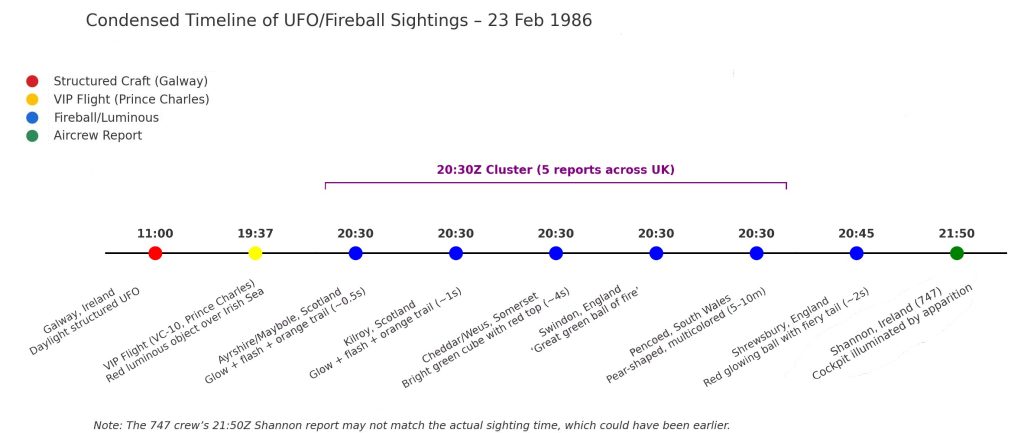
Epilogue & Conclusion
The evening reports between 20:30 and 21:50 on 23 February 1986 could, in theory, be explained by a superbolide meteor: a 1–3 m object fragmenting at ~50 km altitude, producing a fireball visible across ~800 km. Yet no such event appears in scientific or astronomical archives, and aside from mentions in the MOD UFO files, the Northern UFO News and the Sunday Mirror, it left no official trace – no meteor bulletin, no press coverage of a continent-brightening event.
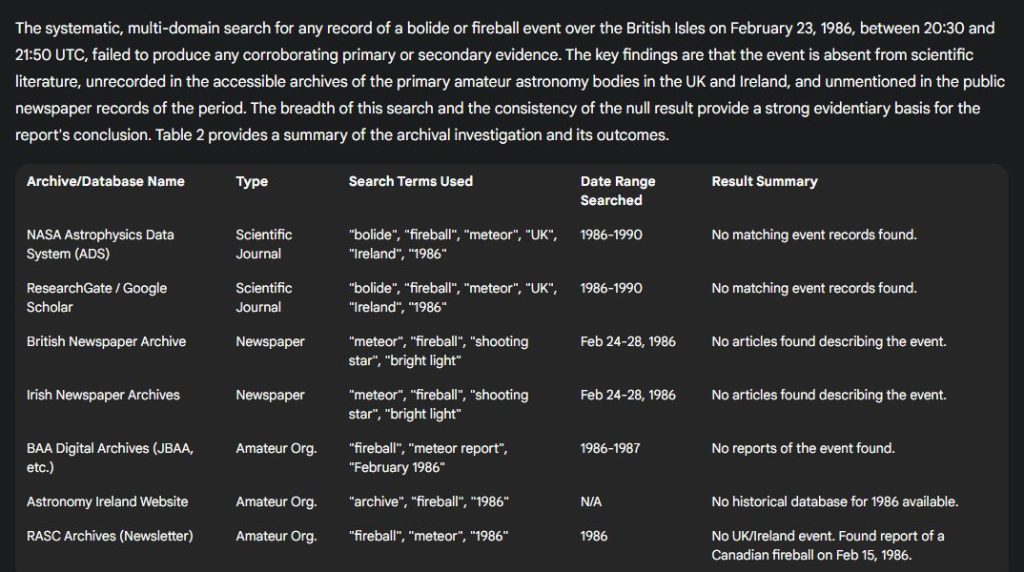
What stands out most is the five concurrent reports at 20:30 – from Scotland, England, and Wales – describing very different objects: fleeting flashes and trails, a cube-shaped luminous form, a green fireball, and a multicolored dome that lingered for minutes. These accounts resist being collapsed into a single meteor explanation.
Crucially, the Galway daylight sighting (11:00) and the VIP VC10 encounter over the Irish Sea (19:37) do not fit a meteor narrative, and the 747 cockpit illumination near Shannon further complicates the picture. While some accounts resemble fireball activity, the overall pattern suggests something more complex: a linked sequence of distinct aerial anomalies involving civilian, military, and royal actors. This makes the events of 23 February 1986 one of the most unusual and significant aerial mysteries of the decade.
This article is part of a series, all related to an unexplained sighting I had in 1986 in Ireland:
- Precognition of the Space Shuttle Challenger Disaster
- UFO Over Galway Bay Chapter 1: The 1986 Salthill Encounter
- The Black UFO Report: Prince Charles, a Jumbo Jet, and a Night of Aerial Mysteries
- UFO over Galway Bay Chapter 2: Psychic Mayday from a crashed UFO
- UFO over Galway Bay Chapter 3: The Irish Tuatha Dé Danann as Cosmic Visitors
- Watch “The Arrival of the Tuatha Dé Danann” Music Video
- UFO Over Galway Bay Chapter 4: Reverse Engineering The Quantum Coupled Transistor
- The Quantum-Coupled Transistor (QCT): Amplifying the Void
- Can Information Travel Faster Than Light – Without Breaking Physics?

